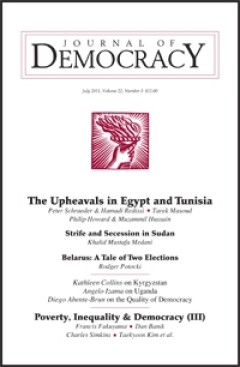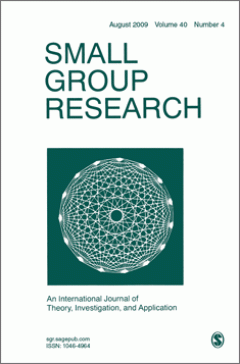Filter by

The Role of Digital Media
Widely reported as “Facebook revolutions,” the upheavals in Tunisia and Egypt show that social media not only can ignite protests but also can help to determine their political consequences.
- Edition
- Volume 22, Number 3, July 2011,pp. 35-48
- ISBN/ISSN
- 10455736
- Collation
- -
- Series Title
- Journal of Democracy
- Call Number
- -

Belarus : A Tale of Two Elections
Strongman Alyaksandr Lukashenka’s suspiciously lopsided 2010 electoral victory—and subsequent crackdown on dissent—may seem like a repeat of the events of 2006, but much has changed in the interval, and his regime is much more precarious today.
- Edition
- Volume 22, Number 3, July 2011,pp. 49-63
- ISBN/ISSN
- 10455736
- Collation
- -
- Series Title
- Journal of Democracy
- Call Number
- -

Uganda : Museveni’s Triumph and Weakness
Despite signs of a cautious willingness to allow more political competition, the regime of newly reelected president Yoweri Museveni fell back on familiar habits of brutal repression when public unrest followed a sudden spike in the cost of living.
- Edition
- Volume 22, Number 3, July 2011,pp. 64-78
- ISBN/ISSN
- 10455736
- Collation
- -
- Series Title
- Journal of Democracy
- Call Number
- -

Dealing with Inequality
Many new democracies have faltered due to high levels of inequality and a deep polarization between the rich and poor. What is the relationship between modern liberal democracy and socioeconomic inequality?
- Edition
- Volume 22, Number 3, July 2011,pp. 79-89
- ISBN/ISSN
- 10455736
- Collation
- -
- Series Title
- Journal of Democracy
- Call Number
- -

Growth and Hunger in India
Despite India’s impressive achievements in democracy, economic development, and the rule of law, it remains home to a third of the world’s poor. Although it has successfully averted famine since independence, it still struggles to prevent chronic hunger.
- Edition
- Volume 22, Number 3, July 2011,pp. 90-104
- ISBN/ISSN
- 10455736
- Collation
- -
- Series Title
- Journal of Democracy
- Call Number
- -

South African Disparities
Despite improvements in South Africa’s socioeconomic landscape and the expansion of the black middle class since the end of apartheid, the country’s levels of poverty and inequality remain high and heavily correlated with race.
- Edition
- Volume 22, Number 3, July 2011,pp. 105-119
- ISBN/ISSN
- 10455736
- Collation
- -
- Series Title
- Journal of Democracy
- Call Number
- -

“Mixed Governance” and Welfare in South Korea
How did South Korea lift itself from destitution to affluence? And how was its ruthlessly authoritarian regime able to metamorphose into a stable democracy? Coopting the business and voluntary sectors to deliver welfare positioned the country to accomplish both.
- Edition
- Volume 22, Number 3, July 2011,pp. 120-134
- ISBN/ISSN
- 10455736
- Collation
- -
- Series Title
- Journal of Democracy
- Call Number
- -

Strife and Secession in Sudan
After decades of civil war, Sudan is set to divide into two nations on 9 July 2011. Yet a number of explosive issues—including the drawing of borders and sharing of oil revenue—have still not been resolved, and the prospects for peace appear to be dimming.
- Edition
- Volume 22, Number 3, July 2011,pp. 135-149
- ISBN/ISSN
- 10455736
- Collation
- -
- Series Title
- Journal of Democracy
- Call Number
- -

Kyrgyzstan’s Latest Revolution
Having thrown out a corrupt, authoritarian president for the second time, this Central Asian republic has gained a new chance at securing a real democratic transition.
- Edition
- Volume 22, Number 3, July 2011,pp. 150-164
- ISBN/ISSN
- 10455736
- Collation
- -
- Series Title
- Journal of Democracy
- Call Number
- -

Evidence of Structure-Specific Teamwork Requirements and Implications for Tea…
This article reports an experiment using the C3Fire microworld—a functional simulation of command and control in a complex and dynamic environment—in which 24 three-person teams were organized according to either a functional or multifunctional allocation of roles. We proposed a quantitative approach for estimating teamwork requirements and comparing them across team structures. Two multiple li…
- Edition
- Vol. 42 no. 5, October 2011.pp. 507-535
- ISBN/ISSN
- 10464964
- Collation
- -
- Series Title
- Small Group Research
- Call Number
- -

Creativity in Virtual Work : Effects of Demographic Differences
Organizations are increasingly using virtual teams, in which individuals work with their teammates across distance and differences, using a variety of information and communication technologies. In this study, the authors examined how demographic differences (i.e., differences in race, sex, age, and nationality) between individuals working virtually affected their collective creativity. Specifi…
- Edition
- Vol. 42 no. 5, October 2011.pp. 536-561
- ISBN/ISSN
- 10464964
- Collation
- -
- Series Title
- Small Group Research
- Call Number
- -

“It’s Not Conflict, It’s Differences of Opinion” : An In-Depth Examin…
To properly manage conflict, the mechanisms of the complex conflict process must be understood. Building on existing research, the purpose of this study was to develop a better understanding of the conflict process by examining nonprofit board member experiences with task, process, and relationship conflict, identifying latent conditions that influence the likelihood of these conflict types, an…
- Edition
- Vol. 42 no. 5, October 2011.pp. 562-594
- ISBN/ISSN
- 10464964
- Collation
- -
- Series Title
- Small Group Research
- Call Number
- -

Self-Governance Through Group Discussion in Wikipedia : Measuring Deliberatio…
Virtual teams and other online groups can find it challenging to establish norms that allow them to effectively balance task and relational aspects of their discussions. Yet, in our reliance on organizational and team theories, small group scholars have overlooked the potential for learning from examples offered by online communities. Theories of deliberation in small groups offer scholars a wa…
- Edition
- Vol. 42 no. 5, October 2011.pp. 595-634
- ISBN/ISSN
- 10464964
- Collation
- -
- Series Title
- Small Group Research
- Call Number
- -

Auditors’ understanding of evidence : A performance audit of an urban devel…
This article uses a case study to analyse two main dilemmas that performance auditors face when auditing complex interventions in governance. The first dilemma, concerning the performance auditors’ roles as improvement agents and independent controllers, is that the improvement agenda often implies interacting closely with the auditees whereas controlling requires independence. The second dilem…
- Edition
- Vol. 17 no. 3, July 2011.pp. 217-231
- ISBN/ISSN
- 10464964
- Collation
- -
- Series Title
- Evaluation
- Call Number
- -

An argument-based approach to validity in evaluation
To maximize the impact of research on programs, this article proposes a ‘reaching-down—reachingup’ perspective in evaluation design, whereby it serves two functions simultaneously: the program improvement function, reaching down, and the knowledge development function, reaching up. This proposal frames applied research as a particular species of evaluation. As validity is a fundamental assessme…
- Edition
- Vol. 17 no. 3, July 2011.pp. 233-246
- ISBN/ISSN
- 13563890
- Collation
- -
- Series Title
- Evaluation
- Call Number
- -

Evaluating the utilisation of resources in higher education institutions : Th…
All over the world, there is pressure on higher education institutions (HEIs) to admit increasing numbers of students. In most parts of Sub-Saharan Africa, however, the increasing demand for student places at HEIs is in the context of enormous reductions in the availability of institutional resources. Efforts at the expansion of enrolments have focused on expanding the availability of resources…
- Edition
- Vol. 17 no. 3, July 2011.pp. 247-259
- ISBN/ISSN
- 13563890
- Collation
- -
- Series Title
- Evaluation
- Call Number
- -

Evaluating aid : An adolescent domain of practice
This article addresses the question ‘Does aid work?’ by asking ‘How do we know if it works?’ Despite substantial refinement in evaluation approaches, evaluation remains without any orthodoxy about how to assess effectiveness. The article examines the purposes of evaluation to discern unresolved tensions between accountability and an organizational learning approach. This is framed by the curren…
- Edition
- Vol. 17 no. 3, July 2011.pp. 261-276
- ISBN/ISSN
- 13563890
- Collation
- -
- Series Title
- Evaluation
- Call Number
- -

Design and application of a system of evaluation indicators for municipal cul…
The publication of Agenda 21 for Culture in 2004, gave rise to significant growth in the area of evaluating public cultural policies. Despite these efforts, however, many challenges still remain on the long road to consolidating municipal cultural policies. We put forward a system of evaluation indicators aimed at managers and policy makers interested in evaluating local cultural policies withi…
- Edition
- Vol. 17 no. 3, July 2011.pp. 277-291
- ISBN/ISSN
- 13563890
- Collation
- -
- Series Title
- Evaluation
- Call Number
- -

Multiculturalism’s new fault lines : Religious fundamentalisms and public p…
This paper seeks to critically examine the emergence of contemporary religious fundamentalisms and how they have been able to acquire influence in a way that has opened new ‘fault lines’ within multiculturalist public policy discourse. Specifically, the paper is interested in understanding the curiously paradoxical place of religion and faith based groupings in the contemporary multicultural po…
- Edition
- Vol. 31 no. 3, August 2011.pp. 343-364
- ISBN/ISSN
- 02610183
- Collation
- -
- Series Title
- Critical Social Policy
- Call Number
- -

Early implementation of the Mental Capacity Act 2005 in health and social care
This paper discusses the early implementation of the Mental Capacity Act 2005 in health and social care in England. The author examines the research evidence to date, particularly monitoring data from the Department of Health, in order to review the progress made in implementation. The extent to which the Act is achieving its overall aim of facilitating decision-making by people lacking capacit…
- Edition
- Vol. 31 no. 3, August 2011.pp. 365-387
- ISBN/ISSN
- 02610183
- Collation
- -
- Series Title
- Critical Social Policy
- Call Number
- -
 Computer Science, Information & General Works
Computer Science, Information & General Works  Philosophy & Psychology
Philosophy & Psychology  Religion
Religion  Social Sciences
Social Sciences  Language
Language  Pure Science
Pure Science  Applied Sciences
Applied Sciences  Art & Recreation
Art & Recreation  Literature
Literature  History & Geography
History & Geography